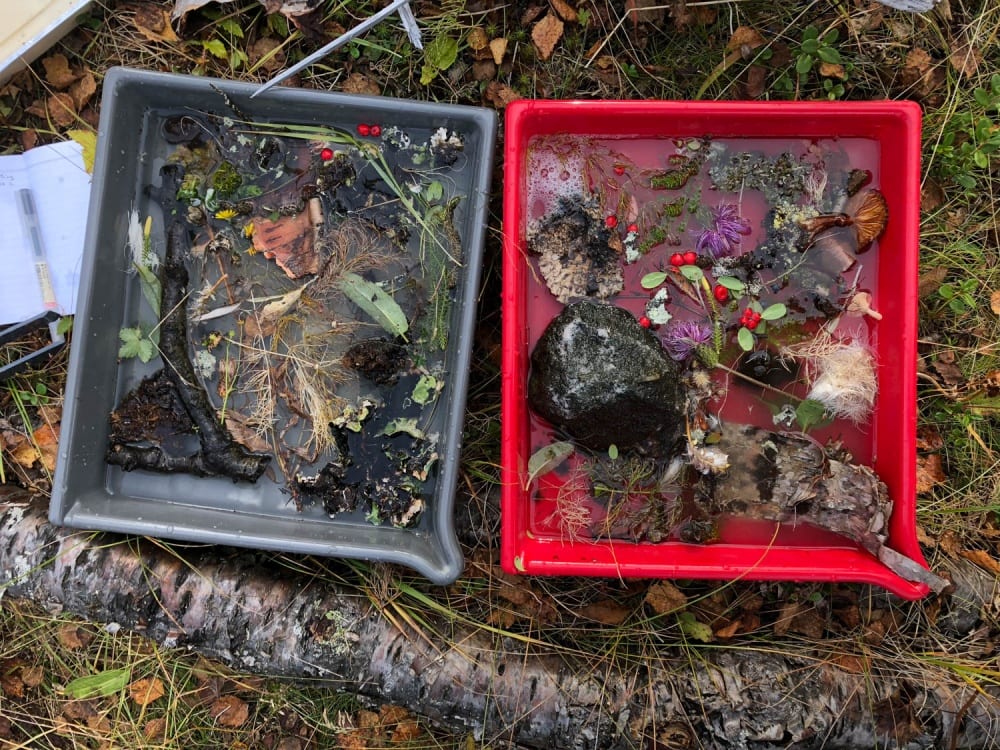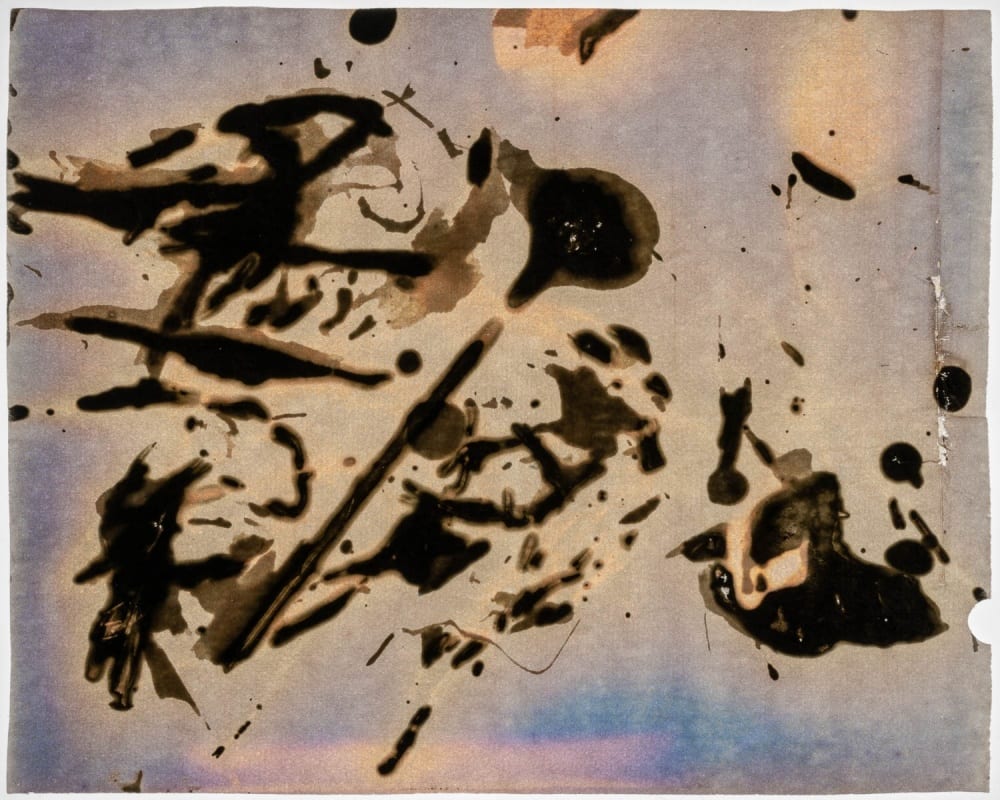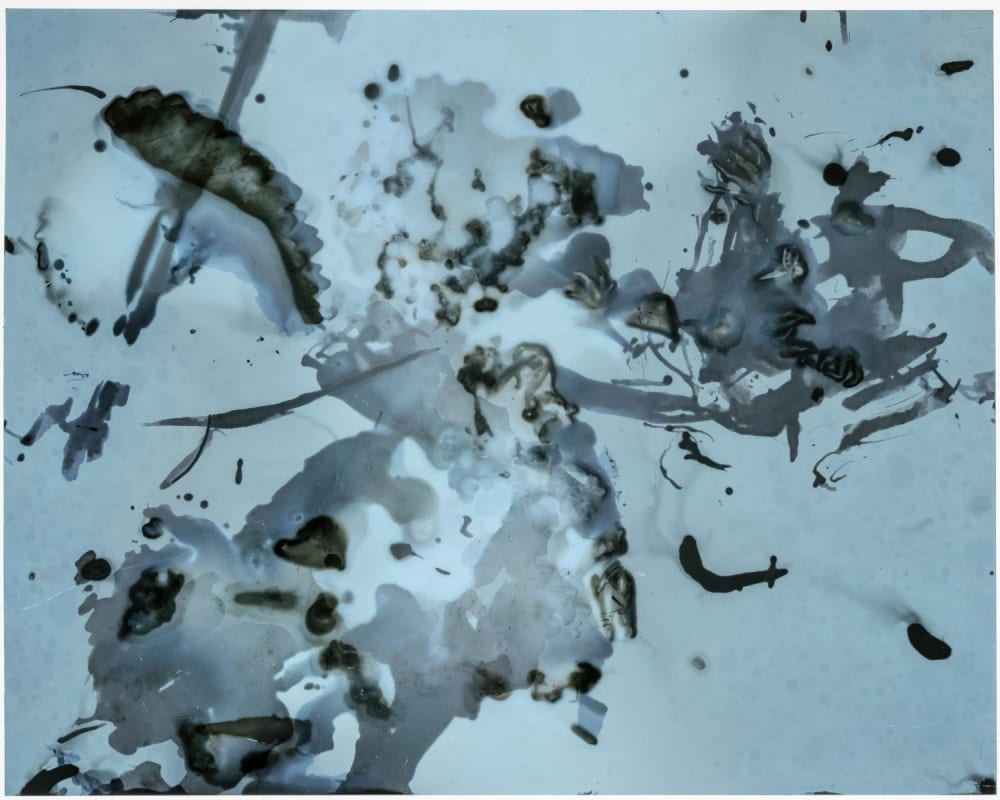Experimenting with the image-making capacity of plants—photography without light.
Among all the arts, it is the art of alchemy which most closely imitates nature.
—Albertus Magnus (teacher of St. Thomas Aquinas), ca. 1250
I found myself on the banks of Lake Kilpisjärvi in sub-Arctic Finland last autumn. I was there with a group of other artists, media researchers and biohackers for the Bioart Society’s Field_Notes conference. Our agenda was to explore the ancient art of augury (divination), examining how we might divine or sense signs from the organic and inorganic worlds that we are a part of but that also operate beyond rational human knowledge. We approached this from the perspective that sense and sensing are forms of divination foretelling the actions we should take as we go about life. Each day we set ourselves the task of finding tools for divination in the ecology, places, and materials around Kilpisjärvi. With experience in photographic alchemy, I proposed we devise a practice that used the inherent photochemical abilities of plants to produce images, thereby combining natural elements, such as salt and botanical matter in photographic processes. This approach to augury and divination offers a path into the unknown energies and forces contained in the ecology around Kilpisjärvi, and draws on the primal poetics of matter. Taking an alchemical approach, employing experimentation, a little scientific knowledge, a lot of uncertainty and chance, Para-photo-mancy, as I called the practice and resulting images, combined local natural elements—berries, moss, mushrooms, etc.—into a photographic image-making process.1 In so doing, we could consider how Para-photo-mancy might enable a different order of visuality, one that privileges a nonhuman aesthetic and makes it perceptible to sensory experience as a form of divination.
Sam Nightingale, Para-photo-mancy, 2018. Made in collaboration with the plants and lake water at Kilpisjärvi Biological Station and members of “Augury: machines which look at birds.”
The use of alchemic processes and botanical matter appears throughout the history of photography. Even before the conception of photography, the chemicals that went on to define the medium for more than 150 years (from its “official” invention in 1839 until digital imaging became prevalent) were known and used by the alchemists of antiquity. In its most straightforward definition, alchemy, the medieval forerunner of chemistry, is concerned with the transformation and chemical change that occurs between metals or substances. Before the Enlightenment, this was broadly understood to take place as a result of hidden or mysterious forces contained within organic and inorganic matter; alchemists believed these forces could be harnessed and used to transmute imperfect substances into noble and precious forms, such as turning mercury into gold.

Alchemy has an enduring relationship with photography.2 Many of the chemicals ubiquitous to analog photography, such as silver nitrate, silver chloride, nitric acid and salt, which facilitated the “little bit of magic” that Henry Fox Talbot announced with his invention of the photo-negative process he called “calotypes,” are said to have been used by alchemists as far back as the eighth century.3 For example, the transformation of the metal silver into the compound silver nitrate was first attributed to the alchemist Mūsā Jābir ibn Hayyān (Latinized as “Geber”) A.D. 721–815.4 Likewise, mercury, a most prized substance to the alchemists, who were intent on transforming it into gold, was found to be the key ingredient to the daguerreotype photographic method. A chance encounter discovered by Louis Daguerre foretold that mercury’s vapors would materialize a latent image previously exposed on an iodized silver plate.5


The continuity between alchemy and photography is extended further by considering the historical use of botanical matter to make photosensitive materials and images. As Michael Pollan writes, “Plants are nature’s alchemists, expert at transforming water, soil, and sunlight into an array of precious substances”; photosynthesis, the transmutation of light into energy—crucial to a plant’s life—is dramatic evidence of this.6 The chemist and inventor John Herschel was well aware of the alchemical transformation offered by plant chemistry (phytochemistry). His scientific notebooks contain numerous traces of the experiments he conducted, testing the viability of botanical matter for photographic use; countless pages are stained by the evidence of what he called “vegetable photography.”7 These are the marks of the various light-sensitive substances he made by extracting juices from flowers and plant roots to examine their sensitivity to the rays of solar light. His experiments went beyond the “salts of silver and gold” that his contemporaries were using to prepare “photographically impressible” substances. Instead, speculating on the photochemical potential for botanical matter, he claimed that such possibilities “pervade all of nature.” For Herschel, the photographic image is “intimately” connected to nature.8 The use of botanical matter (nature’s alchemists) in light-sensitive substances utilize the plant’s chemistry as an internal force of transformation. It extends both the understanding of what photochemical photography was, is or could be, while having an affinity to alchemic process.

Back at Lake Kilpisjärvi, we prepared for our own “little bit of magic”—augury using photochemical alchemy. We have gathered together a small sample of botanical matter from our location in the daylight makeshift photo lab we have set up, and we are using a process of random selection to decide which elements will be combined to make the Para-photo-mancy images. Like Herschel, we use plants and other organic substances to create photographic forms, however, in his method there remains a reliance on light to produce an image/impression. In Para-photo-mancy, light is not the means by which the image will appear; instead, an alchemical transformation occurs. Botanical matter that has been pre-soaked in an organic solution of ascorbic acid and sodium carbonate is brought into direct contact with the silver compounds contained within the photographic film. This is a formula based on the chemical force of attractions and repulsions: of shifting relationships between acid and alkali. The transformation takes place in either daylight or darkness, as the reaction is not dependant on the presence of light at all. Para-photo-mancy, instead, attempts to harnesses the material and creative agency of botanic matter to bring about an image where “nature” writes itself onto a photographic plate. It is an alchemical process that deviates from and hacks recognized modes of photographic image-making.

While the moss, lichen, leaves, berries, and fungi we have gathered are soaking, we leave the woods returning to the warmth of the nearby field station. For an hour or so we learn about the wind, the trees, and their relation to the Sámi concept of time. My mind drifts to the woods outside and the photographic plates. I think about the energetic forces that are all around us and am reminded of the line from Novalis: “perceptibility is a kind of attentiveness.”9 To perceive (and better understand) the world around us means we must be attentive to that which we can’t normally see. Para-photo-mancy is a part of my ongoing creative practice that develops different modes of perception, turning attention towards those elements, rhythms, and forces that exist at the edge of experience; in Anna Tsing’s words, this is the practice of “the arts of noticing”—perhaps itself another explanation for augury and divination.10
Back in the woods by the lake as the rain starts falling and the temperature drops, we place the soaked botanical matter onto various plates of film I have brought with me, pressing them tight against the film emulsion. The images, impressions, expressions, emanations (call them what you will) that start to emerge are contingent, dependent on the chemical reactions taking place on a molecular level between the phenols in the botanic matter and the silver halide crystals on the sensitized plate. Later, we fix and wash the plates of film, one of the few tasks that uses conventional photochemistry. Expressed within the photographic emulsion is a strange para-photographic image, created not of light but by alchemical energy drawn from the location itself.
Sam Nightingale is a visual artist based in the United Kingdom. His practice investigates what he describes as “spectral ecologies.” Spectral ecologies are haunting presences from another time or place that coalesce into material forms poetically expressed in the ecological conditions of the locations in which he works. Working with photography and experimental photochemical processes, Nightingale explores how spectral ecologies trace human and nonhuman histories and events enmeshed within organic and inorganic life, of salt, soil, and plants, as well as in the built environment. His resulting photographic images attempt to make sensible, the temporalities and spatialities of the world in which we are a part, but that also persist beyond the limits of human experience. His photographic practice draws as much on nature’s capacity as elemental or primal media, as it does on “manmade” media technologies, in order to produce a poetics of human/nonhuman entanglement that recognizes the agency of nonhuman actors. He is undertaking a PhD by practice at Goldsmiths, University of London (The Centre for Research Architecture and Department of Media, Communication & Cultural Studies).
- The suffix –mancy indicates divination by a specified means, such as geo-mancy, which The New English Dictionary defines as “divination by means of lines, figures or dots on the earth or on paper, or by particles of earth cast on the ground.” Many thanks to artist and filmmaker Karel Doing for introducing me to the potential for making photochemical images using the internal chemistry of plants. Details concerning Karel’s method, which he calls “phytogram,” can be found here. ↩
- See Laurie Dahlberg, “The Material Ethereal Photography and the Alchemical Ancestor” in Art and Alchemy, ed. Jacob Wamberg (Copenhagen: Museum Tusculanum Press, University of Copenhagen, 2006), 83–100. ↩
- Douglas R. Nickel, “Talbot’s Natural Magic,” History of Photography 26, no. 2 (June 2002): 132–40. ↩
- Josef Maria Eder, History of Photography, trans. Edward Epstean (New York: Columbia University Press, 1945), 22. ↩
- Idem., 228. ↩
- Michael Pollan, The Botany of Desire: A Plant’s-Eye View of the World (London: Bloomsbury, 2003), xvii. ↩
- John F. W. Herschel, “On the Action of the Rays of the Solar Spectrum on Vegetable Colours, and on Some New Photographic Processes,” Philosophical Transactions of the Royal Society of London 132 (January 1842): 196. ↩
- Idem., 201. ↩
- Walter Benjamin quotes this line from the poet Novalis in his discussion of the aura, the uncanny sense of an object that looks back at its perceiver. Walter Benjamin, Selected Writings, vol. IV: 1928–1930 (Cambridge, MA, 2003), 338. ↩
- Anna Tsing, The Mushroom at the End of the World: On the Possibility of Life in Capitalist Ruins (Princeton, NJ: Princeton University Press, 2015). ↩




